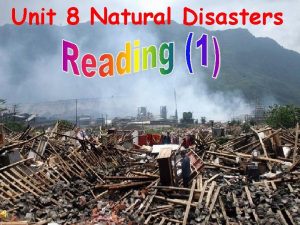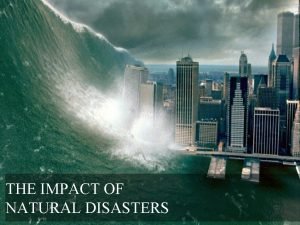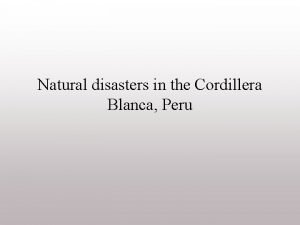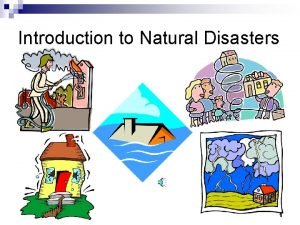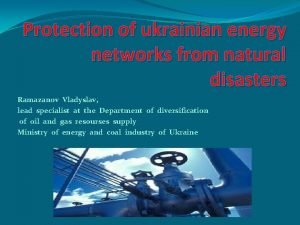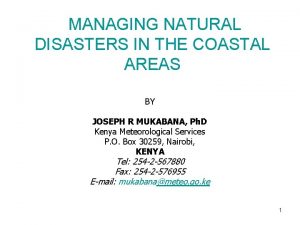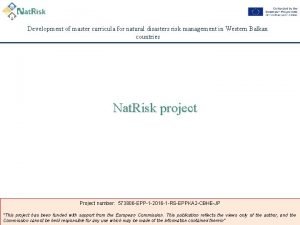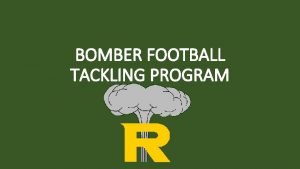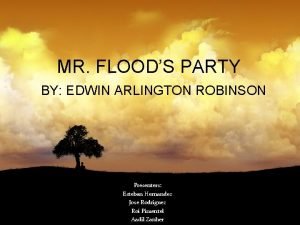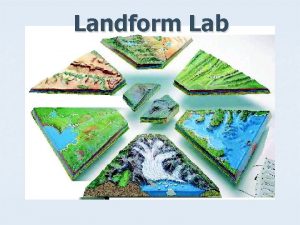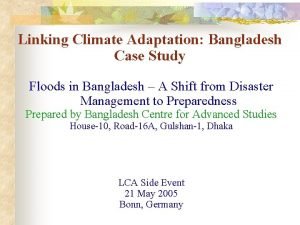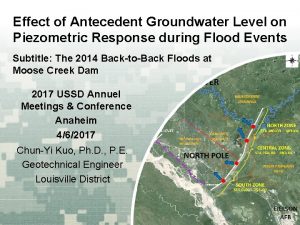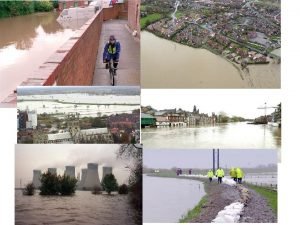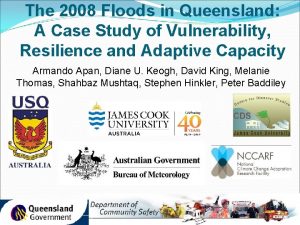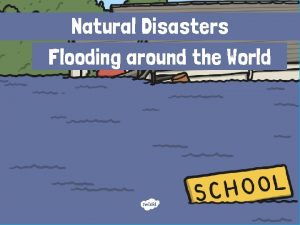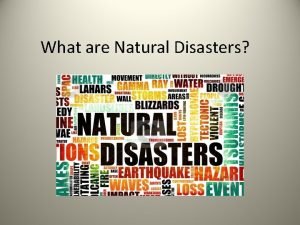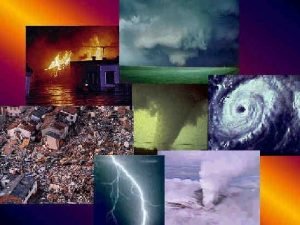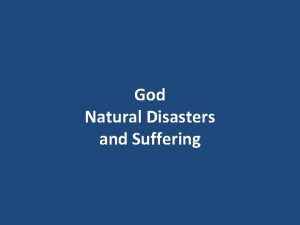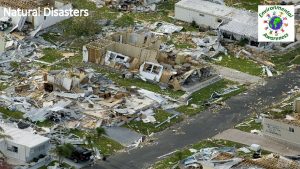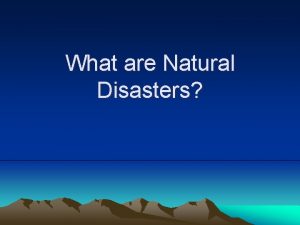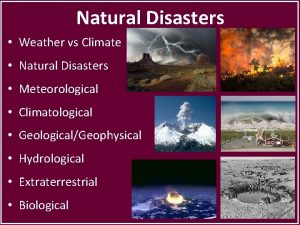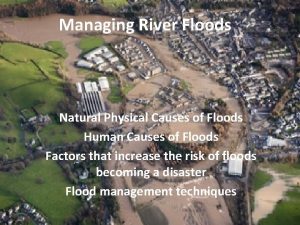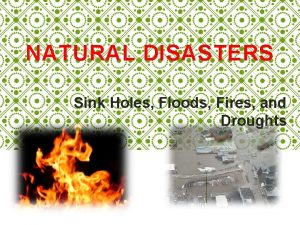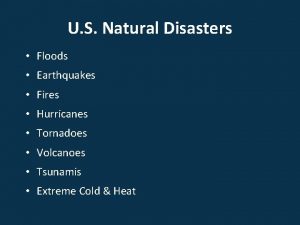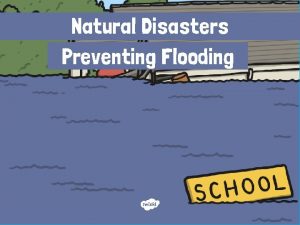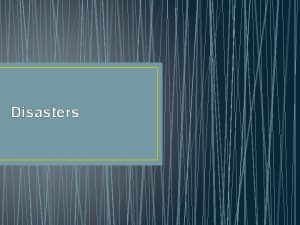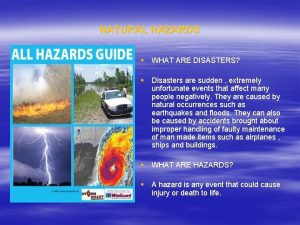Natural disasters Floods Flooding near Key West Florida

























- Slides: 25

Natural disasters: Floods Flooding near Key West, Florida, United States from Hurricane Wilma's storm. October 2005.

Philipines, 2013. Tropical Storm Trami.

The Great Mississippi and Missouri Rivers Flood of 1993

Tsunami. Miyako, Japan 2011. Concrete seawalls, breakwaters or other structures are meant to protect the country against high waves, typhoons or even tsunamis.

The Great Vargas Landslide, Venezuela. 1999.

The Great Vargas Landslide, Venezuela. 1999.

The Great Vargas Landslide, Venezuela. 1999.

The Great Vargas Landslide, Venezuela. 1999.

The Great Vargas Landslide, Venezuela. 1999. - The mudslides significantly altered more than 60 kilometres (37 mi) of the coastline in Vargas.

The Great Vargas Landslide, Venezuela. 1999. -The disaster caused estimated damages of USD $1. 79 to $3. 5 billion. - More than 8, 000 homes were destroyed, displacing up to 75, 000 people.

- Over 70% of the population of the state of Vargas was affected by the disaster. Public services, like water, electricity, phone lines, and land transportation (roads and bridges) completely disappeared in some places. - There were no supplies of food and water for months, so most of the population had to be evacuated.

- Looting and sacking sprouted up everywhere, forcing the military to implement martial law for more than a year.

- The death toll was considered to be between 10, 000 and 30, 000 — some say 50, 000. (New government had just been elected). The exact number of casualties is difficult to determine as there was no reliable census data.

The Johnstown Flood by David Mc. Cullough whirling: spinning. curbstone: row of stones (curb shaped). Edge between side walk and road. ingrain: made of fibers. christening: the Christian sacrament. plow: farm implement used to till the ground. dangle: hang loosely and swing. tilting: inclining. pansies: a kind of flower with petals of various colors. shudder: trembling motion or vibration. perilous: dangerous or risky. gush: to flow in great volume. leap: to move quickly or jump. jagged: irregular. surge: rise. ominous: threatening. gruesome: horribly repugnant. gable: triangular part of roof.

Answer: 1. - What is James Quinn worried about? 2. - How does his sister-in-law respond to his concerns? 3. - Why didn’t Mr. Quinn move his family to the hill in the morning?

Answer: 4. - What was the Quinn’s house like? 5. - Why does the author describe the big house and playhouse in such detail? 6. - What happened to the playhouse, and to Gertrude’s aunt?

The Johnstown Flood In literature, mood is a literary element that evokes certain feelings or vibes in readers through words and descriptions. Usually, mood is referred to as the atmosphere of a literary piece, as it creates an emotional situation that surrounds the readers. Mood is developed in a literary piece through various methods. It can be developed through setting, theme, tone and diction.

The Johnstown Flood The manner in which a writer approaches this theme and subject is called the tone. The readers always rely on the writer’s point of view of the events taking place in a story. They observe the story through his eyes. They feel the way the writer feels about the events taking place and the description provided. Therefore, the attitude of the writer evokes feelings and emotions in the readers. Diction is the choice of words a writer uses. Diction or choice of words conveys deep feelings as well as represents the events, places and characters in a literary work in specific colors, having an effect on the way the readers feel about them.

The Johnstown Flood 1. - Reread lines 22 to 28 What mood do the unusual details The detail that tells about how Gertrude dangled her feet in create? the water, which covered the yard, creates a mood of impending danger. The water, which is already rising, should not be high enough for Gertrude to dangle her feet in it from the porch. The datail of purple pansies floating face up in the yellow wáter creates a mood of doom because the flowers were no longer in the ground. The water as it is described yellow is

The Johnstown Flood 2. - Reread lines 37 to 50 What details help create a mood of terror? Some of the details that create a mood of terror include Gertrude’s father’s intructions to run for their lives, his face “white and terrified-looking”, his repeated command not to go back for anything, and the water being close to Rosemary’s chin.

The Johnstown Flood 3. - Reread lines 116 to 122 What do details about the dead horse contribute to mood of the passage? The incongruous image of the dead horse “bobbing up and down ”like a gigantic gruesome rocking horse” intensifies the mood of hopelessness and panic. A rocking horse is a symbol of childhood fun, the contrast makes the situation seem even more surreal and ominous.

The Johnstown Flood In literature, a conflict is a literary element that involves a struggle between two opposing forces usually a protagonist and an antagonist. An internal conflict arises as soon as a character experiences two opposite emotions or desires; usually virtue or vice, or good and evil inside him. This disagreement causes a character to suffer mental agony. External conflict, on the other hand, is marked by a characteristic involvement of an action wherein a character finds himself in struggle with those outside forces that hamper his progress.

The Johnstown Flood 4. - Reread lines 148 to 177 a. - How is the conflict resolved? b. - What builds suspense just before this resolution? a. - The conflict is resolved when Mr. Mc. Achren throws Gertrude to Mr. Koch, and he catches her. b. - The men’s failed attempt to reach the raft and the unsure attempt to catch Gertrude build suspense.

The Johnstown Flood After you finish reading the story, order the events chronologically. Use your notebook.

The Johnstown Flood Critical Thinking How can luck, chance or quick thinking save you from a disaster?
 Flooding in key west
Flooding in key west Natural hazards vs natural disasters
Natural hazards vs natural disasters Taiwan earthquake
Taiwan earthquake Natural disasters listening
Natural disasters listening Political impact of disaster slideshare
Political impact of disaster slideshare Natural disasters in the cordillera region
Natural disasters in the cordillera region Definition of disaster
Definition of disaster Helike greece
Helike greece Three natural disasters
Three natural disasters Natural disasters conclusion for project
Natural disasters conclusion for project Natural disasters conclusion for project
Natural disasters conclusion for project Natural calamities definition
Natural calamities definition Introduction natural disasters
Introduction natural disasters Natural disasters
Natural disasters Natural disasters
Natural disasters Natural disaster unit 9
Natural disaster unit 9 Ancient natural disasters
Ancient natural disasters Near foot near shoulder tackling
Near foot near shoulder tackling Mr flood's party theme
Mr flood's party theme Ladysmith floods 1994
Ladysmith floods 1994 Wizer constructive and destructive forces
Wizer constructive and destructive forces Flooding in bangladesh case study
Flooding in bangladesh case study Disadvantages of flood
Disadvantages of flood Conclusion of floods
Conclusion of floods York floods 2000
York floods 2000 2008 floods mackay
2008 floods mackay


